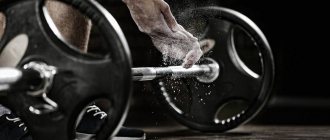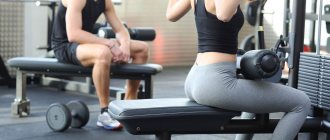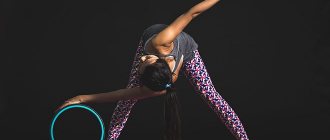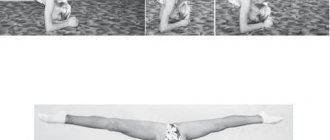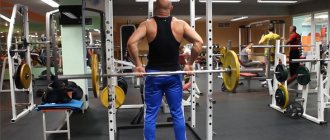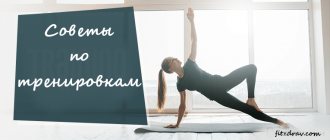Exercises and programs for home and gym - in the guide from Soviet Sport.
Loading…
The neck muscles are often ignored in training, and in vain - a strong neck saves you from injuries and sprains, helps get rid of headaches, and just looks great. Exercises and programs for home and gym - in the guide from Soviet Sports.
Neck muscles. What it is
There are more than 15 muscles in the neck. They are needed to keep the head horizontal and turn it. The neck muscles protect the spine and help with swallowing movements. The blood supply to the brain passes through the cervical region and nerve impulses are communicated.
Squatting correctly - a complete guide to exercise No. 1
Why pump up your neck muscles?
But ultimately, all this is secondary. Because the main thing is that a strong, inflated neck looks great in itself, and you need to train it if only for this reason. For centuries, people have judged a person's strength by his neck. You can’t hide your neck behind clothes, it’s always visible. In combination with a shaved head and a gold chain, a muscular neck will save you from many questions from the outside world.
Neck workout. Body-building
The neck muscles are challenged in a number of classic bodybuilding exercises - such as deadlifts, shrugs, and standing dumbbell lateral raises.
If you are progressing in the “base” and adding mass without problems, you may not need to specialize in the neck muscles. Include shrugs in your program on shoulder day or back day - raising your shoulders and trapezius up while standing with a barbell in your arms.
The technique of this exercise is simple: you keep your back tense, with a slight arch in the lower back. The grip of the barbell is slightly wider than shoulder width. As you inhale, raise your shoulders up, as if shrugging them. As you exhale, lower it back down. Do 3-4 working sets of 8-12 repetitions and increase the working weights. Combined with the deadlift, this exercise will give you the neck you've ever dreamed of.
Neck workout at home
You can train your neck muscles at home without any equipment. You should approach training with caution and increase the resistance gradually - especially if you have not previously engaged in strength training and development of cervical muscles.
Start your workout with a warm-up. Movements should be smooth and slow. Rotate your head clockwise and counterclockwise 10 times in each direction. Raise your head up and lower it until your chin touches your chest – 15 times. Turn your head alternately to the left and right shoulder - 10 times. Turn your head left and right, trying to tilt your ear to your shoulder - 10 times.
Arnold's biceps, Van Damme's splits, Lundgren's platform - make yourself a super hero of the 90s
- Crunch in a child's neck
When you have warmed up, we begin the main exercises. Place your hand with your palm just above your left ear, tense your hand - overcoming resistance, try to move your hand using the force of your neck muscles. Do 10-15 times, then change hands.
Place your hands at the back of your head. Try to move your arms using the force of your neck muscles - 10 times. Then put your hands on your forehead, resting your forehead, overcome the resistance of your hands - 10 times. Rest for a minute. Repeat the entire cycle 2-3 more times.
Wrestling exercises to train neck muscles
Gradually, training your neck muscles at home can become more complicated. Try training your neck in a wrestling style. Rest your forehead, palms and feet on the floor - make small rocking movements from your forehead to the back of your head. Having mastered the exercise, help yourself less with your hands and transfer the main load to the neck muscles. The height of skill is when you do the exercise without any hands at all.
Lie on your back, stand in a bridge position, keeping your head on the floor. While pushing with your feet, make movements with your head, rolling from the back of your head to the top of your head and back.
Neck training with weights
You can add neck training to your strength program - doing it on the same day you train your shoulders or back.
Lie on your back on a bench - so that your head and neck hang from it. Place it on your forehead, holding the weight plate away from the barbell with your hands. Move your head down slightly, and then, using the force of your neck muscles, return it to its original position. 3 sets of 12-15 times.
If the gym has a special pad for training the neck muscles, add the following exercise to your training: put the pad on your head, attach a weight to it and sit on a bench - raise and lower your head. 3 approaches – 12-15 times.
Attention! When training your neck muscles, avoid sudden movements with large amplitudes. They can lead to sprain and injury to the spine. Consult your doctor for contraindications!
It gets quieter in the stands. Alexander Tikhonov leaves big biathlon politics Alexander Tikhonov’s departure from big biathlon politics is the main result of the SBR coaching council.04.04.2019 14:30BiathlonOkhotnikov Stepan
Russian Hanyu in a skirt. Kostornaya captivated everyone at the French Grand Prix. At the Grand Prix series tournament in Grenoble, Alena Kostornaya won a magnificent victory. Olympic champion Alina Zagitova – second.02.11.2019 23:30Figure skatingTigai Lev
Shcherbakova is ahead, Tuktamysheva fell. But she also has a chance at the Grand Prix final. The fourth stage of the Grand Prix series has started in China. Among the women, after the short program, Russian Anna Shcherbakova is in the lead. Elizaveta Tuktamysheva is fourth so far.08.11.2019 15:00Figure skatingTigai Lev
Johannes Book of Records. We study the super season of Be Jr. The 2018/19 World Cup ended with the complete triumph of the Norwegian Johannes Boe, who set a lot of all kinds of records. 03/27/2019 19:47BiathlonTigai Lev
Goodbye legend. Halvard Hanevold has died. He was 49. Three-time Olympic champion Halvard Hanevold died in Asker, Norway, at the age of 50. The cause of death has not yet been announced.03.09.2019 22:15BiathlonMysin Nikolay
Mikhail Galaktionov: We congratulated Chalov on his goal for CSKA. We are waiting for him to break into the national team. The head coach of the Russian youth team spoke about preparations for the qualifying round matches of the European Championship with Latvia and Serbia.11.11.2019 14:15FootballGrigorievskaya Julia
Shcherbakova - in the Grand Prix final. Tuktamysheva was not allowed in by the judges. At the tournament in China, Anna Shcherbakova won a landslide victory and reached the Grand Prix final. Elizaveta Tuktamysheva lost to Japanese Satoko Miyahara in the fight for silver.09.11.2019 15:00Figure skatingTigai Lev
“Yurlova for the season – five plus!” Assessments for biathletes for the season “Soviet Sport” continues to sum up the results of the biathlon season. Today - about the performance of the Russian women's team.03.27.2019 09:00BiathlonVolokhov Yuri
A title is the best gift. Rublev won the Kremlin Cup on his 22nd birthday. Adrian Mannarino reached the final of the Moscow tournament for the second year in a row, and lost for the second time in a row. 10/20/2019 19:30 Tennis Nikolay Mysin
Roman Rotenberg: We are adopting Cherchesov’s experience - his approach is very interestingFirst Vice-President of the Russian Hockey Federation - about plans and prospects for the development of Russian hockey.11/10/2019 09:00 HockeyElena Kuzyutina
Strengthening the neck
Good news for those who don’t know how to pump up their neck at home - exercises to strengthen your neck muscles can be done at home, as a complement to your workouts at the gym. You can pump your neck both on a business trip and on vacation, because the same rubber band obviously won’t take up much space. And if there is no tourniquet, then you can train using your own hands.
As with other muscle groups, exercises for the neck muscles should begin with a warm-up.
For the neck muscles, the warm-up consists of stretching exercises:
- Bend your head forward, resting your hand on the back of your head
- Bend your head forward, trying to touch your chin to your chest
- Chin lifts and turns
- Head tilts with left and right turns
- Chin lifts with left-right rotation
- Tilts of the head to the shoulder (left-right)
Perform these exercises 6-10 times, where the range of motion reaches its maximum, hold for a couple of seconds.
Then you will need a rubber band. If it is not available, you can use hand resistance.
- Head turns
- Head lifts
Each exercise is performed in two sets of 10-12 times.
Now let's look at strength exercises for the neck.
- Lifting your head with weights while lying on your back
- Lifting your head with weights while lying on your stomach
You can use a barbell or other heavy object as a weight. Each exercise is performed in 4 sets of 10-12 times.
The style of execution (and this applies to all exercises for the neck) is smooth, without jerking or excessive effort. And no attempts to beat your own record.
It is enough to do this set of exercises once a week. It turns out something like impact training for these muscles, plus, the neck itself is gradually trained when performing many other exercises. In addition, it should be noted that shrugs greatly contribute to strengthening the neck muscles.
By doing shrugs, you involuntarily pump up your neck muscles.
This is the first stage of training. The complex is quite sufficient for a bodybuilder or powerlifter, and even more so, sufficient for an office worker. At the same time, it is a good prevention of osteochondrosis of the cervical spine. But this is not enough for a serious powerful neck or contact martial arts.
How to pump up your neck with a strap?
A massive neck combined with broad shoulders and a pumped trapezoid will create a lasting impression on your figure. How to achieve this? There are lucky people with excellent genetics, whose neck volume increases on its own, in the process of training the back and deltoids: for example, from performing rows to the chin and shrug.
Among the cult stars of bodybuilding, Tom Platz was undeniably one of them, whose specialty was the ability to resist a tightening noose.
But if you are not such a unique person, then, in addition to all of the above, you still need to know a secret: how to pump up your neck using a strap (an excellent tool that allows you to dilute your training and focus on one of the most difficult and truly stubborn muscle groups)…
By strap we mean a combination of strong elastic straps, on the free end of which a weight is suspended. The main requirement for a strap is convenience and reliability of fastening on the head. Every time, check how correctly you have dressed it; if the straps come off while working with weights, unpleasant consequences may occur due to a sudden movement of the head.
You don’t need too much time to effectively pump up the target muscle group in question using this device. The training itself will only take you about a quarter of an hour, and only once a week - it is not recommended to do more due to the high risk of injury in this area.
The musculature of the neck consists of one and a half dozen muscles, very mobile, but quite vulnerable in combination with the vertebrae. The complex includes only 2 movements, performed in the “forward-backward” and “left-right” planes. Before each of them you need to do 1 warm-up set without weights.
Avoid any rotational movements - they are extremely dangerous.
Lateral head lifts
Starting position – lying on your side on the edge of a bench. The strap is securely fastened to the head, the weight hangs freely, not reaching the floor. Slowly tilt your head to your shoulder strictly vertically, then also slowly lift it, avoiding jerks and accelerations. The maximum range of motion and breathing rhythm are important.
At the beginning of the climb, inhale, then hold your breath to avoid shaking your head. Exhale at the top point. Keep your muscles constantly tense; relaxation can lead to involuntary jerking of the head and injury. This exercise strengthens the junction of the neck and trapezium, giving a “square” appearance to the shoulder girdle.
Head abduction
Lie with your stomach down on a horizontal bench so that your collarbones slightly protrude over the edge. Lower your head, inhale and, holding your breath, slowly lift it up.
At the top point, the eyes should look straight ahead; if the gaze turns out to be from under the brows, reduce the weight. Then exhale and begin the reverse movement. This exercise targets the neck and spinal extensor muscles.
The higher you raise your head, the more benefits you will get from the workout.
To get a good workout across the entire target area with the strap, not counting your warm-up sets, perform 2 sets of 12 reps for both exercises. Beginners should initially practice without additional weights, since their own head also has sufficient mass.
Attention!
Do not train this zone when you are tired or on “heavy” days; it is better to do it together with aerobic exercise or on a rest day.
Also, don’t forget about the wrestling bridge in all its variations. In combination with the above exercises, the wrestling bridge will simply explode your muscles, giving them a good impulse to gain strength, increase in volume and qualitative growth...
However, always remember the golden rule of proportional addition - the volumes of the neck, lower leg and biceps should be approximately equal. And cone-shaped "wrestler" necks will not bring you dividends in the arena of competitive bodybuilding.
Source: https://iron-arms.ru/trenirovka/sheya/kak-nakachat-sheyu-s-pomoschyu-lyamki.html
Exercises with weights to develop the neck muscles
Athletes often train in combination with deltoids and trapezius. However, if at the end of the workout you perform several isolating elements (purely on the neck), the effect produced will double.
- Raising the head from the “lying on your back” position. This type of exercise is best performed on a flat horizontal surface. The head, upper spine and shoulders should remain suspended. A weight plate from a barbell is placed on the center of the forehead, previously covered with a towel, and held in place with both hands. Exhale - the chin slowly reaches towards the chest, inhale - return to the starting position. 6-8 repetitions. This element will help those who are interested in how to pump up their neck at home (instead of iron, you can take any weight), because all tissues are being worked on. This exercise can be performed with dumbbells.
- Raising the head from the “lying on your stomach” position. Work on the same principle as in the previous exercise, only you need to lie on your stomach and hold the pancake with your hands on the back of your head. Exhale - the head stretches back, and so on for 6-8 repetitions.
- Traction with a strap. A special strap will help you quickly pump up your neck, the first side of which is thrown over the head, and the other is used to attach the load. The initial pose is the body bending forward to a right angle. Exhale - the head slowly lowers lower until the weight touches the floor, and after that the athlete returns to the starting position. Repeat 6-8 times.
Important! Inflating your neck with a strap is quite dangerous. This type of exercise can only be performed by professional, experienced athletes with previously trained muscles.
How to pump up a wrestler's neck
A well-developed neck is not only the calling card of professional wrestlers, but also symbolizes masculinity and commands respect. The neck is always visible and, unlike the muscles of the arms or legs, it is quite difficult to hide it under clothes; it is unlikely that if you constantly wear turtlenecks or turtleneck sweaters. But then what to do in the summer if you have a neck like a pencil?
Let's look at how to pump up our neck and what it will give us.
In fact, not only the external component is important; having a massive neck is certainly enviable, but developed neck muscles also protect against injuries, for example, they can protect against vertebral fractures or reduce the degree of concussion.
Yes, we are not often in danger of breaking a cervical vertebra or getting a concussion. At the same time, we often sleep in an uncomfortable position, stretch our necks forward when working at the computer, or strain during any household manipulations, as a result of which pain occurs in the neck or head.
Such pain occurs from weakness of the neck muscles and poor blood supply to the brain. Trained neck muscles help correct posture and improve blood supply to the brain, enriching it with oxygen and nutrients.
Therefore, you should pump up your neck not only for a spectacular and impressive appearance, but also to prevent injuries and ensure the normal functioning of the body in everyday life.
Also, the neck muscles serve as a stabilizer in many strength exercises, for example, in the deadlift and standing barbell press, so if they are sufficiently developed, they can influence the results in the exercises.
Nevertheless, many people neglect neck training, believing that this muscle group grows from indirect load, or they don’t think about working it out at all. This approach is absolutely unjustified; evidence of this is provided by examples of disproportion in the development of the neck muscles, when, with a large total body mass, the neck and head look like a lollipop.
There are four main reasons why neck training is essential:
- injury prevention
- improving overall well-being
- functional strength development
- improving posture and giving a masculine appearance
How to pump up your neck
Now that we have decided for what purpose we should shake our neck, let's figure out how to do it as efficiently as possible, and most importantly, safely.
First, let's define the methods of neck training. You can pump up your neck using dynamic and static methods, that is, performing various exercises with resistance for the number of repetitions or the time of holding under load.
A classic in training the neck muscles is the wrestling bridge in its various varieties, this includes its frontal version and running on the bridge, as well as the most difficult version, the vertical bridge standing on your head with your feet against the wall.
Important!
This exercise owes its name to martial arts, namely wrestling, where it has proven itself excellent as a basic exercise in training wrestlers of various disciplines. Undoubtedly, this is the best time-tested exercise for training the neck muscles, but there is also a stumbling block in training the neck with it.
This is a very dangerous exercise, especially for unprepared athletes; to perform it you need to have a strong spine and neck muscles to be in good shape. Otherwise, there is a danger of breaking or injuring already fragile vertebrae, or at least getting a strain in the neck muscles.
Of course, on the wrestling bridge alone the wedge did not meet and you can pump up your neck with other effective and at the same time safe exercises. But if your choice fell on the wrestling bridge, then before you start performing this exercise, you should prepare your body and primarily strengthen your neck muscles.
At the beginning of neck training, it is enough to use exercises with overcoming the resistance of the hands; for this you can use your hands or ask a partner.
Neck workout with resistance
- For the back of the neck - arms crossed at the back of the head, overcoming the resistance of the hands with the help of the neck muscles, we tilt the head back;
- For the front part of the neck – rest your palms on your forehead, overcoming the resistance of your hands with the help of your neck muscles, tilt your head forward;
- For the side parts of the neck - rest the palm on the temporal part of the head, overcoming the force of the hand with the help of the neck muscles, tilt the neck to the right or left, depending on the side of the application of force.
In such positions, static holds are performed for 15-30 seconds, and dynamic work in the form of head bends for 20 repetitions for each side.
After spending a month, or better yet two, of such training, you can gradually master the technique of the wrestling bridge, or start working on your neck with the help of weights and exercise machines.
To train the neck muscles in the gym, there are 7 main exercises:
- exercises with overcoming resistance of hands or towel
- Bortsovsky bridge
- working on a machine to train neck muscles
- training using a special collar or straps for neck training with weights
- bending the neck while lying on your back or stomach using weights.
The first months, when you are working with arm resistance, you can train your neck at every workout in the gym at the end of the lesson, then you can switch to 1-2 times a week, depending on your goals and objectives.
Below are training programs for training the neck; you should start with the first complex and after strengthening the muscles, move on to the basic strength program for training a massive neck.
On the subject: Is it possible to pump up your arms with an expander?
Some of the exercises require special equipment, which is usually only available in the gym. Therefore, in the next article we will tell you how to pump up your neck at home.
Before starting a workout, a prerequisite is to warm up the neck muscles using rotational movements and head tilts.
Workout 1
Hold with arms crossed at the back of the head – 3 sets of 15-30 seconds.
Hold with emphasis on the forehead - 3 sets of 15-30 seconds.
Hold with your hand resting on your temple – 3 sets of 15-30 seconds. on each side
Workout 2
Head extensions with arms crossed at the back of the head – 3 sets of 20 reps
Head extensions with arms resting on the forehead - 3 sets of 20 reps
Head tilts with the hand resting on the temple - 3 sets of 20 repetitions
Workout 1 , etc.
Neck Development Training Program: Basic Level
Before starting a workout, a prerequisite is to warm up the neck muscles using rotational movements and head tilts. The first number is the number of repetitions, the second is the number of repetitions, the hyphen is from and to to choose from.
We do not recommend performing a wrestling bridge, so Workout 2 is performed at your own discretion and in the absence of problems with the spine. Otherwise, when training your neck, it is enough to perform the complex Workout 1 .
Workout 1
- Seated head raise with a clamp/flexion in a neck machine/lying neck curl while lying on your stomach with weights (the exercise is selected depending on the availability of equipment) – 3x8-12
- Lateral bending in the neck machine - 3x12 on each side
- Neck curls lying on your back with weights – 3x10
Workout 2
- Front wrestling bridge – 3x20
- Bortsovsky Bridge – 3x20
Workout 1 , etc.
Source: https://muscleoriginal.com/kak-nakachat-sheyu-borca/
Why do you need a strong neck?
In some sports, the neck muscles play a primary role. For example, in freestyle and Greco-Roman wrestling, you have to stand on a bridge for a long time, supporting your own weight plus the weight of the opponent; moreover, in the stand-up position they constantly try to grab the neck, and it’s bad for the one whose neck turns out to be the “weak link”.
Wrestlers get hit in the neck all the time. There are cases when famous freestyle wrestlers and Greco-Romans were forced to leave the sport because their neck muscles, and then their cervical vertebrae, could not stand it. In MMA and Jiu-Jitsu, painful techniques are used on the neck. In boxing, a strong neck helps you “take a punch.”
Strong neck muscles are the prerogative of professional martial artists and rugby players, but in everyday life they protect fragile cervical vertebrae from injury. Therefore, it is imperative to train your neck.
But the leader in the number of neck injuries is American football, where on average there are 40 neck injuries per 1000 practices. Among other things, the neck muscles help withstand heavy loads, for example, in the same rows and squats. On small scales this is not particularly noticeable, but on large scales it is immediately felt.
- Crackling neck when tilting head to the side
Not to mention the fact that a pumped-up neck looks brutal, being, in a way, the calling card of a tough guy. Therefore, sometimes people who are far from sports want to pump up their necks, hoping to immediately acquire a terrifying appearance in the eyes of others.
Why train your neck?
- Health. Perhaps you think it's better to do one extra biceps exercise than to train your neck. Meanwhile, our cervical spine needs a reliable muscular frame
- Safety. For fighters, we can use the term resilience. A strong neck will help you withstand the blows of your opponent in the ring.
- Impressive appearance. As a bonus, you get a serious argument in an argument and just a powerful part of the body that will impress others. Well, or it just won’t stand out from the overall picture of your muscular body
Shaking our necks in the hall
In the gym, in addition to such devices as TPX loops and harnesses, you can use a special exercise machine.
Let's figure out how to use this simulator to pump the front and back of the neck.
- Exercises for the sternocleidomastoid muscles. Now turn your face to the roller and rest your forehead against it. Bend your head forward, overcoming the weight, then return to the starting position. Again, 2-3 sets of 10-12 repetitions will be enough. To diversify your workout, do 1-2 approaches in TPX loops.
- Trapezium exercises. Everything here is classic. Only shrugs, only hardcore.
With what weight to perform the movement is up to you. This could be dumbbells, barbells, weights or a special machine. The main thing is to do 2-3 sets of 10-15 repetitions
- Deltoid exercises. The painting will not be complete if the shoulders lag behind. Therefore, pay enough attention to them! The best movement for the shoulders is abduction.
In second place are pull-ups or barbell rows to the chin.
- How to stretch your neck? A set of exercises for a beautiful neck
And only on the third bench press.
Why is that? Because the shape of the shoulders is formed by the developed middle deltas, and they receive maximum load in the first two exercises! For all movements, perform 2-3 sets of 10-15 repetitions.
How to build a powerful neck
Many novice athletes are wondering how to pump up their neck. This, of course, can be understood, because it is the powerful neck muscles that are a distinctive indicator that demonstrates the athletic physique of their owner. In addition, the neck muscles are visible at any time of the year, and you don’t have to wait until summer to show them off.
Before moving directly to the question “how to pump up neck muscles,” let’s look at its anatomical structure, which will help to understand which specific muscles are involved in the training process.
As is known, the sternocleidomastoid muscle is involved in the formation of the cervical skeleton, in addition, both muscles (upper and lower) of the hyoid bone, which is located directly under the chin, are involved in the process.
It is worth noting that the listed muscles, if they are sufficiently developed, almost completely hide the notorious Adam’s apple, that is, the thyroid cartilage, which is often also called the “Adam’s apple.”
Trapezes play an important role, because they create the external contours of the neck. These muscle groups are responsible for turning and tilting the head, and they also form an athletic posture. According to experts, regular neck training improves blood circulation in the head, reducing fatigue, tiredness and irritability.
The neck muscles respond well to loads, so to pump up the neck of your dreams, just three to four months of regular training is enough.
In bodybuilding, there are two approaches to increasing the volume and strength of the neck muscles: the first involves the use of a special cap made of straps on which weights are hung; the second involves overcoming the resistance of your own hands, or you can use the help of a training partner.
Advice!
Absolutely every exercise for the neck muscles must be performed at a slow, smooth pace, avoiding jerks. In addition, you need to monitor the range of motion, which should be as wide as possible.
Most often, a special training includes 3-4 exercises, performed in three sets of 12-20 repetitions each.
Do not be alarmed at the initial stages; pumping up the neck muscles can cause dizziness and darkening of the eyes. If you notice these symptoms, just rest for a few minutes. You should not choose maximum weights, as you can easily get injured.
Often, novice bodybuilders after a complex on the neck muscles experience unpleasant sensations (overstrain of the larynx muscles, excessive dry mouth, difficulty swallowing or chewing), called sore throat.
There is no need to worry and see a doctor if these symptoms occur; they go away fairly quickly. If symptoms persist for a long time, it is recommended to reduce the load.
After an intense neck workout, when your muscles are warmed up, be careful and avoid various drafts and cold weather, otherwise hypothermia may occur.
Now let's look at how to pump up your neck, that is, what exercises to use.
1) Tilts and turns back and forth and left and right, using hand resistance.
2) Lying on your back or chest on a bench or two placed stools, if you are working out at home, your head is suspended, a weight is attached to your forehead or the back of your head. In this position, you should move your head smoothly up and down.
3) Bend over and focus on your head, carefully begin to make slow movements without jerking or excessive tension.
Attention!
4) There is a special device in the gym with which you can pump up your neck. It looks like a cap made of straps. Put it on your head in a sitting position (elbows resting on your knees), hang the necessary load and bend your head.
5) The Wrestling Bridge can not only strengthen the neck muscles, but also create the desired volume. To begin with, it is recommended to use the help of a partner who will back you up and prevent you from falling or getting injured.
Over time, you can apply additional weights by holding them on your chest. It is recommended to hold the bridge for no more than forty seconds. Let's look at the wrestling bridge technique.
There are two options for execution: 1) you should sit down, put your hands about a meter in front of your feet, then straighten your arms and legs, while lifting your pelvis up.
Next, you should rest your head and put your hands behind your back; 2) the second option is the most difficult; it should be performed with an assistant; make a standard gymnastic bridge, bending your back, bending your arms and resting your head, then placing your hands on your chest.
The listed exercises can be included in the main training program. Before performing them, it is recommended to properly stretch and stretch the neck muscles.
And remember that forced loads are not the main thing, the main role is played by the systematicity and regularity of classes.
If you are persistent and follow safety precautions, then in just a few months you will be able to develop a characteristic “bull” neck.
Source: https://skmuskul.ru/blog/24-sovety-i-rekomendatsii/92-kak-nakachat-moshchnuyu-sheyu.html
The Importance of Neck Strength
Most people are put off by exercising this part of the body because they think they might hurt themselves. But this is precisely the reason why you need to train your neck muscles. To support the cervical spine and skull, these muscles must be strong enough.
There is no doubt that professional athletes (football players or wrestlers) need absolute neck strength. Compared to other athletes, it is wrestlers who have the strongest and most powerfully developed necks. This allows you to protect yourself from damage and choking techniques, and also helps with a missed blow to the head, absorbing and absorbing the blow.
The wrestling bridge is a key exercise for developing neck muscles. However, this exercise is beneficial for the entire body. The work includes the spine and all the muscles of the back of the body. Even the abs, legs and hips are involved. Therefore, it is reasonable to perform the wrestling bridge for absolutely everyone, including women and children.
Cervical spine: anatomy
The organ consists of 18 small muscles responsible for various movements of the oral cavity, circular rotations of the head, and the like. Here are the main muscles:
- Sternocleidomastoid. It is located on the side, and when a person looks forward, it becomes like the Latin letter V.
- The second muscle is attached to the hyoid bone and is located under the chin.
- Trapezoidal. This muscle is responsible for the function of rotating the head, and in addition helps to keep the upper part of the spine in a straight position, brings the shoulder blades together, raises the shoulders, etc.
In addition to these main ones, there are many auxiliary and additional muscle groups.
Exercise options
If you can perform a classic wrestling bridge for a few minutes without much effort, then you're probably ready for the next step. The goal is to lift your hands off the floor. In this case, the body weight will be completely on the head and neck. As an intermediate step, you can prop yourself up on your toes.
There is also an exercise called the “wrestling bridge run.” To perform it, you need to take the starting position, as in the classic version, and then start running your legs around your head. The head is constantly turned to one side and does not come off the mat. The runs are performed clockwise and counterclockwise for several turns.
Warm-up and warm-up gymnastics
Start any strength exercises aimed at pumping muscles with a slow, light warm-up. It warms up sedentary muscles and helps avoid ruptures and strains of tendons and muscles during training.
Each exercise in the warm-up must be performed in two sets of ten times.
- Tilts forward and backward. Start your training with them. Perform these movements while standing upright with your arms extended along your body. Make every movement carefully and meaningfully - the cervical vertebrae do not tolerate negligence.
- Turns. To perform them correctly, sit on a flat, hard surface. Turn only your neck and head; you don’t need to help yourself with your shoulders and body, otherwise the effect will be minimal.
- Side bends. Be especially careful not to hurt yourself - tilt your head until your ear touches the top of your shoulder. Hold yourself in this position for two seconds, then lean to the other side.
- Rotation. It happens both clockwise and counterclockwise. Make a full rotation in one direction, then slow down and reverse the movement.

